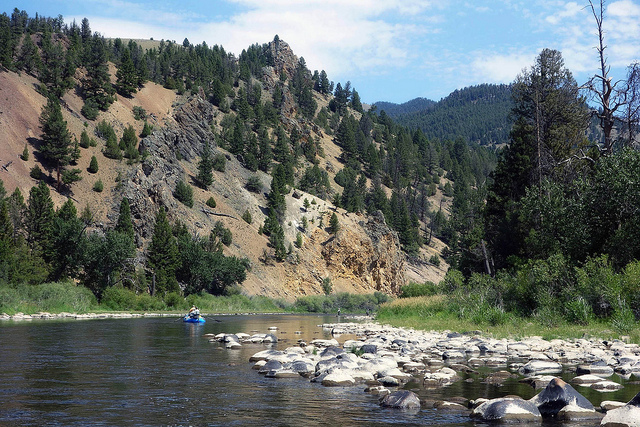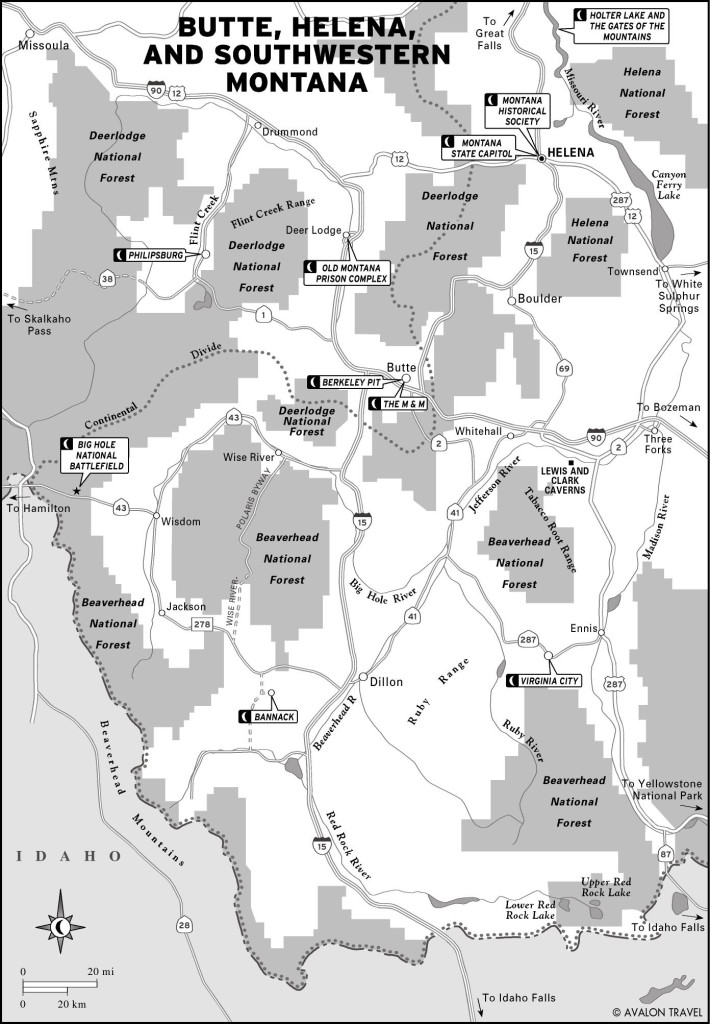
Rafters on the Big Hole River. Photo © Tom Hart, licensed Creative Commons Attribution.

Butte, Helena, and Southwestern Montana
Surrounded on three sides by the meanderings of the Big Hole River, the Pioneer Mountains are in fact two different ranges divided down a north-south axis, linked yet separated, sort of like the underside of a coffee bean. These out-of-the-way mountains come to life in the winter; a hot springs resort and a small downhill ski area combine to bring in the locals. In the summer the hills are covered with violet-blue lupine. The Wise River drainage is popular with anglers; there are several large Forest Service campgrounds with fishing access along the river.Highway 484 bisects the Pioneer Mountains, from Wise River in the north through Polaris to Highway 278 in the south. The Forest Service has designated this route running down the furrow of the coffee bean as the Pioneer Mountains Scenic Byway.
The legendary heavy snows of southwestern Montana are put to good use at the homey, family-oriented Maverick Ski Area (406/834-3454, Thurs.–Sun.), where the vertical drop is 2,020 feet. Maverick Lodge offers lessons, rentals, day care, and food; cross-country skiers are welcome. A lift ticket is only $30 per day, $20 for children, but there are only 24 runs and one real lift.
Many skiers come up for the day from Dillon, but the closest lodging to Maverick is the Grasshopper Inn (406/834-3456, $60), with motel rooms and a restaurant at the base of the slopes beside the near–ghost town of Polaris.
This venerable resort (13 miles north of Hwy. 278 on Hwy. 484, 406/834-3434 or 800/722-8978) is the other popular lodging for skiers. Cross-country skiers converge here; with 25 miles of cross-country trails managed by the resort, an entire mountain range of informal trails to explore, and a good hot soak to come home to, this is near-heaven (at an elevation of 7,385 feet, literally so). In summer the hot springs are popular for hikers. There are two outdoor mineral pools plus a sauna, and it costs $6 ($4 for kids) for a swim.
Rooms are either in the lodge ($45 and up, bathroom down the hall) or in rustic cabins scattered among the trees. The restaurant in the lodge is open for three meals a day. Cabins, with electricity and wood-burning stoves but no plumbing (an outhouse is shared with neighboring cabins), start at $70 for a double (swimming included). Don’t come to Elkhorn expecting a trendy New Age getaway; it’s funky and remote, and with that in mind, charming and relaxing.
If you want to stop at Elkhorn for a swim and a soak but would prefer to camp out, the very pretty Forest Service Grasshopper Creek Campground (June–mid-Sept., $10) is less than one mile down the road. Pick up the Blue Creek trail just south of the campground and head into the West Pioneers. North of Elkhorn Hot Springs are several more campgrounds and trailheads.
At this Forest Service–maintained site four miles north of Elkhorn Hot Springs (406/683-3900, $5 per vehicle), rock hounds can dig for quartz crystals. It’s a very popular spot, attracting dedicated amateur crystal miners who come with shovels and screens to sift through the dirt for quartz and amethyst. But even ill-equipped novices can scrape through the topsoil for a few minutes and come up with a small crystal or two.
Excerpted from the Eighth Edition of Moon Montana.